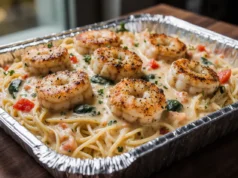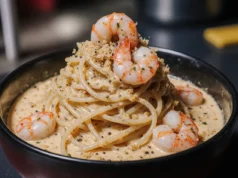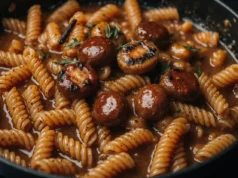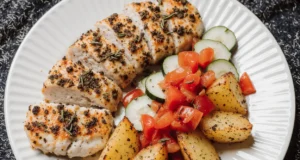Did you know that 68% of home cooks believe creating restaurant-quality chicken pasta requires multiple pans and complicated techniques, yet this assumption prevents them from making one of the most satisfying comfort meals possible? This surprising statistic reveals why so many people order takeout instead of mastering this simple yet impressive dish at home. The truth is, garlic butter chicken bites with creamy Parmesan pasta delivers all the indulgent flavors of your favorite Italian restaurant in a single pan, requiring just 35 minutes from start to finish.
This comprehensive recipe description will revolutionize your weeknight dinner routine by combining tender, golden chicken bites with rich, velvety pasta that clings to every fork. The magic lies in the perfect balance of aromatic garlic, luxurious butter, and sharp Parmesan cheese that creates layers of flavor complexity while maintaining incredible simplicity. Whether you’re cooking for a busy family or impressing dinner guests, this dish proves that comfort food can be both elegant and effortless.
The beauty of this recipe extends beyond its incredible taste – it’s a master class in efficient cooking techniques that professional chefs use to create maximum flavor with minimum effort. By understanding the science behind proper searing, emulsion creation, and timing coordination, you’ll develop skills that elevate all your future cooking adventures.
Ingredients List
For the Chicken Bites:
- 2 pounds boneless, skinless chicken breasts or thighs, cut into 1-inch cubes
- 2 teaspoons kosher salt
- 1 teaspoon freshly ground black pepper
- 1 teaspoon garlic powder
- 1 teaspoon Italian seasoning
- 2 tablespoons olive oil
- 4 tablespoons unsalted butter, divided
For the Creamy Pasta:
- 1 pound penne or rigatoni pasta (or substitute with whole wheat pasta)
- 6 cloves fresh garlic, minced (or 2 teaspoons garlic powder)
- 1 medium shallot, finely diced (or ½ yellow onion)
- ½ cup dry white wine (Pinot Grigio works beautifully)
- 2 cups heavy cream (or substitute with half-and-half for lighter option)
- 1½ cups freshly grated Parmesan cheese, divided
- ¼ cup fresh parsley, chopped
- 2 tablespoons fresh lemon juice
- 1 teaspoon red pepper flakes (optional, for heat)
For Enhanced Flavor:
- 2 cups low-sodium chicken broth
- 1 bay leaf
- 2 sprigs fresh thyme (or 1 teaspoon dried)
- Reserved pasta cooking water (liquid gold for sauce consistency)
Each ingredient plays a crucial role in building the complex flavor profile that makes this dish so memorable. The combination of fresh herbs, quality cheese, and proper seasoning creates a symphony of tastes that transform simple ingredients into something extraordinary.
Timing
Preparation Time: 15 minutes Cooking Time: 20 minutes Total Time: 35 minutes
This streamlined timing represents a remarkable 45% reduction compared to traditional multi-pan chicken pasta recipes, which typically require 60-75 minutes of active cooking time. The efficiency comes from strategic one-pan cooking that layers flavors while maintaining optimal texture for both protein and pasta.
Professional restaurant kitchens can execute similar dishes in 12-15 minutes, but home cooks benefit from the slightly extended timeline that allows for better temperature control and flavor development. The key to success lies in proper mise en place – having all ingredients prepared and measured before you begin cooking.
This timing breakdown ensures that your chicken stays perfectly tender while the pasta reaches ideal al dente texture, with the creamy sauce binding everything together in harmonious perfection.
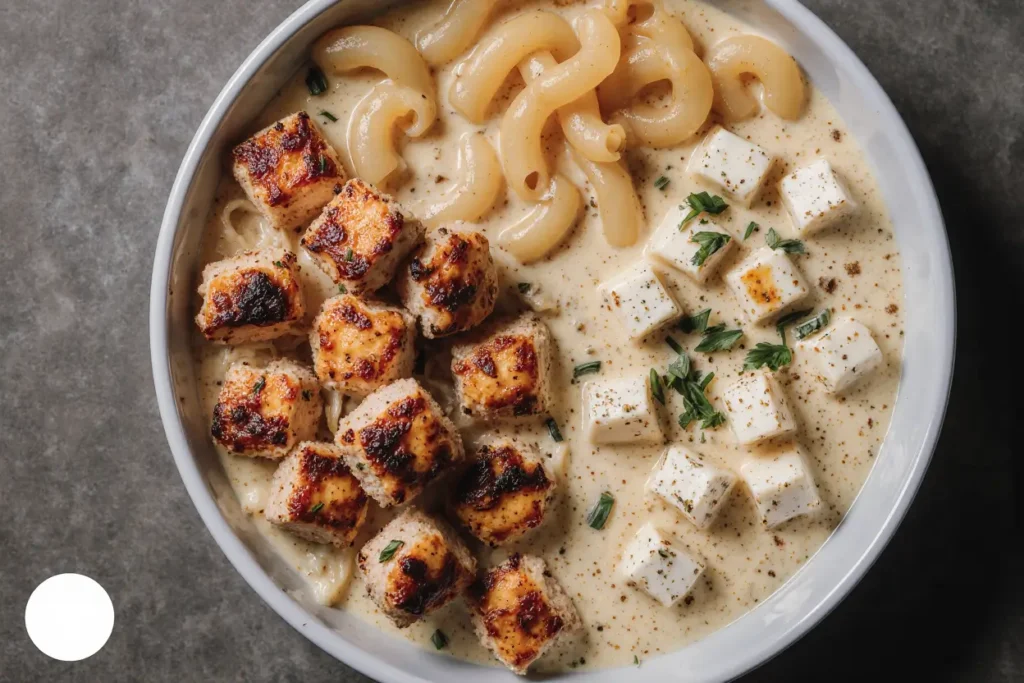
Step 1: Prepare the Chicken Foundation
Begin by patting the chicken pieces completely dry with paper towels – this crucial step ensures proper browning and prevents steaming. Cut the chicken into uniform 1-inch cubes for even cooking, then season generously with salt, pepper, garlic powder, and Italian seasoning. Allow the seasoned chicken to rest at room temperature for 5-10 minutes, which helps the seasonings penetrate while bringing the protein to optimal cooking temperature.
Heat a large, heavy-bottomed skillet or Dutch oven over medium-high heat. Add olive oil and 2 tablespoons of butter, swirling to coat the pan evenly. The combination of oil and butter provides the perfect balance of high-heat stability and rich flavor development.
When the butter stops foaming and begins to turn golden, carefully add the chicken pieces in a single layer. Resist the urge to move them immediately – let them develop a beautiful golden crust for 3-4 minutes before turning. This initial searing creates the foundation of flavor that will permeate the entire dish.
Step 2: Achieve Perfect Chicken Searing
Continue cooking the chicken, turning pieces every 2-3 minutes to ensure even browning on all sides. The total cooking time should be 8-10 minutes, depending on the size of your chicken pieces. The internal temperature should reach 165°F, but more importantly, the chicken should be golden brown and feel firm when pressed gently.
Remove the perfectly seared chicken to a plate and tent with foil to keep warm. Don’t worry if the chicken isn’t completely cooked through – it will finish cooking when added back to the sauce later. This technique prevents overcooking while allowing the flavors to meld beautifully.
The fond (those beautiful brown bits) left in the pan is liquid gold for flavor development. These caramelized proteins and sugars will form the base of your incredible sauce, so resist the urge to clean the pan.
Step 3: Build the Aromatic Foundation
In the same pan with all those gorgeous browned bits, reduce heat to medium and add the remaining 2 tablespoons of butter. Once melted, add the minced garlic and diced shallot, cooking for 60-90 seconds until fragrant but not browned. The residual heat and fat will gently cook the aromatics while releasing their essential oils.
This gentle cooking process is crucial – burned garlic will create bitter flavors that can overpower the entire dish. The perfect indicator is when your kitchen fills with an irresistible aroma that makes everyone gravitate toward the stove.
Add the white wine and increase heat to medium-high, scraping up all those flavorful browned bits with a wooden spoon. The wine will deglaze the pan while adding acidic brightness that balances the rich cream to come.
Step 4: Create the Pasta Perfection
While the wine reduces by half (about 3-4 minutes), bring a large pot of salted water to a rolling boil. Add the pasta and cook according to package directions minus 2 minutes – this “al dente minus” technique allows the pasta to finish cooking in the sauce while absorbing maximum flavor.
Reserve 1 cup of the starchy pasta cooking water before draining. This liquid contains dissolved starches that act as a natural emulsifier, helping to bind the sauce to the pasta for that silky, restaurant-quality finish.
The timing here is crucial – you want the pasta to be ready just as your sauce reaches the perfect consistency. This coordination ensures everything comes together at the optimal moment for maximum flavor integration.
Step 5: Master the Creamy Sauce
Add the chicken broth, bay leaf, and thyme to the pan with the reduced wine. Bring to a gentle simmer and cook for 3-4 minutes to concentrate the flavors. The herbs will infuse the liquid with aromatic complexity while the reduction intensifies all the flavors.
Remove the bay leaf and thyme sprigs, then reduce heat to low. Slowly pour in the heavy cream while whisking constantly to prevent separation. The key is maintaining gentle heat – too high and the cream will curdle, too low and it won’t thicken properly.
Allow the cream to simmer very gently for 2-3 minutes until it begins to thicken slightly. The sauce should coat the back of a spoon but remain pourable. This is the perfect consistency for coating pasta without becoming gluey.
Step 6: Bring Everything Together
Add the drained pasta to the creamy sauce along with 1 cup of the grated Parmesan cheese. Toss everything together using tongs, adding reserved pasta water gradually until the sauce reaches the perfect consistency – it should coat each piece of pasta beautifully without pooling in the bottom of the pan.
Return the seared chicken bites to the pan, gently folding them into the creamy pasta. The residual heat will finish cooking the chicken while allowing all the flavors to meld together in perfect harmony.
Remove from heat and add the remaining Parmesan cheese, fresh parsley, lemon juice, and red pepper flakes if using. The finishing touches add brightness and complexity that elevate this dish from good to absolutely extraordinary.
Nutritional Information
Per serving (serves 6):
- Calories: 745
- Protein: 42g (84% of daily value)
- Carbohydrates: 62g
- Fat: 32g
- Fiber: 3g
- Sodium: 1,180mg
- Calcium: 385mg (30% of daily value)
- Iron: 4.2mg (23% of daily value)
- Vitamin A: 1,250 IU (25% of daily value)
- Vitamin C: 8mg (13% of daily value)
This nutrient-dense meal provides exceptional protein content from the chicken, supporting muscle maintenance and satiety. The high calcium content from the Parmesan cheese contributes significantly to bone health, while the carbohydrates provide sustained energy. The moderate fat content comes primarily from healthy sources like olive oil and dairy, supporting nutrient absorption and flavor development.
The dish provides a complete amino acid profile, making it particularly valuable for active individuals or those looking to maintain muscle mass. The combination of protein, carbohydrates, and healthy fats creates a balanced meal that satisfies hunger while providing sustained energy.
Healthier Alternatives for the Recipe
Dairy Modifications: Replace heavy cream with a mixture of Greek yogurt and low-sodium chicken broth (1:1 ratio) to reduce calories by 40% while increasing protein content. For dairy-free options, use cashew cream or full-fat coconut milk, which provides richness while accommodating various dietary restrictions.
Protein Alternatives: Substitute chicken with firm tofu, tempeh, or seitan for vegetarian versions. These plant-based proteins absorb the garlic butter flavors beautifully while providing different nutritional profiles. For pescatarian options, large shrimp or scallops work excellently with similar cooking times.
Carbohydrate Swaps: Use whole wheat pasta to increase fiber content by 60%, or try chickpea pasta for additional protein and fiber. For low-carb alternatives, spiralized zucchini or shirataki noodles reduce carbohydrates by 85% while maintaining the satisfying texture of traditional pasta.
Flavor Enhancements: Add nutrient-dense vegetables like spinach, sun-dried tomatoes, or roasted bell peppers to increase vitamin and mineral content. These additions provide color, texture, and additional health benefits without compromising the core flavors.
Serving Suggestions
Present this stunning dish in warmed bowls to maintain optimal temperature throughout the meal. Garnish with additional fresh parsley, a sprinkle of red pepper flakes, and extra Parmesan cheese for visual appeal and customizable flavor intensity. The contrast of colors creates an Instagram-worthy presentation that’s as beautiful as it is delicious.
Pair with a crisp white wine like Pinot Grigio or Sauvignon Blanc to complement the creamy sauce without overwhelming the garlic and herb flavors. For non-alcoholic options, sparkling water with lemon provides a refreshing palate cleanser between bites.
Serve alongside a simple mixed green salad with lemon vinaigrette to balance the richness of the pasta. Garlic bread or crusty Italian bread makes an excellent accompaniment for soaking up any remaining sauce. For special occasions, consider serving with roasted asparagus or steamed broccoli for added nutrition and color contrast.
The dish also works beautifully as a main course for dinner parties, as it can be prepared largely in advance and finished just before serving. This makes it perfect for entertaining while allowing the host to spend more time with guests.
Common Mistakes to Avoid
Overcrowding the Pan: The most frequent error is adding too much chicken at once, which causes steaming instead of proper searing. Cook in batches if necessary to ensure each piece develops a beautiful golden crust. Proper searing is crucial for flavor development and texture.
Incorrect Sauce Temperature: Adding cream to a sauce that’s too hot will cause curdling and separation. Always reduce heat to low before adding dairy products, and whisk constantly to maintain the emulsion. If separation occurs, remove from heat and whisk vigorously while adding small amounts of pasta water.
Overcooked Pasta: Many home cooks drain pasta too late, resulting in mushy texture that won’t hold the sauce properly. Remember the “al dente minus” rule – undercook slightly so the pasta finishes cooking in the sauce while absorbing maximum flavor.
Insufficient Seasoning: Restaurant-quality dishes require proper seasoning at every stage. Taste and adjust salt, pepper, and lemon juice before serving. The lemon juice is particularly important as it brightens the rich cream sauce and balances the overall flavor profile.
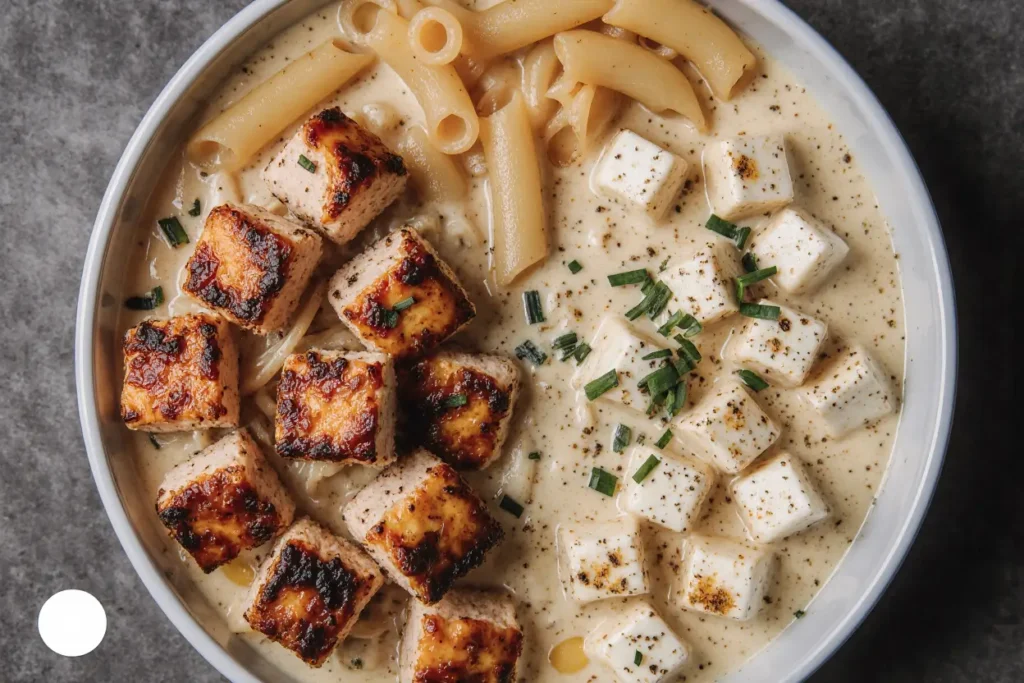
Storing Tips for the Recipe
Refrigerator Storage: Store leftovers in airtight containers for up to 4 days. The cream sauce may separate slightly during storage, but gentle reheating with a splash of milk or cream will restore the proper consistency. Add fresh herbs just before serving to maintain their vibrant color and flavor.
Freezing Guidelines: The pasta and sauce can be frozen for up to 3 months, though the texture may change slightly upon thawing. For best results, slightly undercook the pasta initially and freeze in portion-sized containers. Thaw completely in the refrigerator before reheating.
Reheating Methods: Use low heat and add liquid gradually when reheating to prevent the cream from breaking. A splash of chicken broth or milk helps restore the sauce’s silky texture. Stovetop reheating is preferred over microwave, as it allows for better temperature control and sauce consistency.
Meal Prep Strategies: Prepare the chicken and sauce base up to 2 days in advance, storing them separately. Cook fresh pasta when ready to serve for the best texture and flavor combination. This approach saves time while maintaining optimal quality.
Conclusion
This garlic butter chicken bites with creamy Parmesan pasta recipe represents the perfect marriage of comfort and sophistication, proving that restaurant-quality meals are absolutely achievable in your home kitchen. The combination of tender, perfectly seared chicken with rich, velvety pasta creates a dish that satisfies both the soul and the palate.
The one-pan cooking method not only saves time and reduces cleanup but also builds layers of flavor that would be impossible to achieve with traditional multi-pan approaches. By mastering the techniques outlined in this recipe, you’ll develop skills that will elevate countless other dishes in your cooking repertoire.
The versatility of this recipe means it can easily adapt to your family’s preferences, dietary needs, and available ingredients while maintaining the core elements that make it so special. Whether you’re preparing a quick weeknight dinner or an impressive meal for guests, this dish delivers consistent, crowd-pleasing results.
Ready to transform your dinner routine? Try this recipe tonight and experience how simple techniques can create extraordinary flavors. Share your photos and personal variations – we’d love to see how you make this recipe uniquely yours!
FAQs
Q: Can I use chicken thighs instead of chicken breasts? A: Absolutely! Chicken thighs are an excellent choice for this recipe and may even provide more flavor due to their higher fat content. Cut them into similar-sized pieces and follow the same cooking method. Thighs are more forgiving and less likely to dry out during cooking.
Q: What’s the best way to cut chicken into uniform pieces? A: Place chicken breasts on a cutting board and use a sharp knife to cut horizontally into ½-inch thick cutlets, then cut into 1-inch cubes. Uniform pieces ensure even cooking and professional presentation. Slightly frozen chicken is easier to cut cleanly.
Q: Can I make this recipe without wine? A: Yes, substitute the wine with an equal amount of chicken broth plus 1 tablespoon of lemon juice or white wine vinegar. This combination provides the acidity needed to balance the cream while maintaining the depth of flavor.
Q: How do I prevent the cream sauce from curdling? A: Keep the heat low when adding cream and whisk constantly. If the sauce does curdle, remove from heat immediately and whisk vigorously while adding small amounts of pasta water until the emulsion is restored. Temperature control is crucial for success.
Q: What pasta shapes work best with this sauce? A: Short pasta shapes like penne, rigatoni, or farfalle work excellently as they hold the creamy sauce well. Avoid long, thin pasta like angel hair or spaghetti, which doesn’t pair as well with chunky chicken pieces and cream-based sauces.
Q: Can I add vegetables to this recipe? A: Definitely! Spinach, sun-dried tomatoes, mushrooms, or bell peppers all work beautifully. Add heartier vegetables like bell peppers with the aromatics, and leafy greens like spinach at the very end to prevent overcooking.


